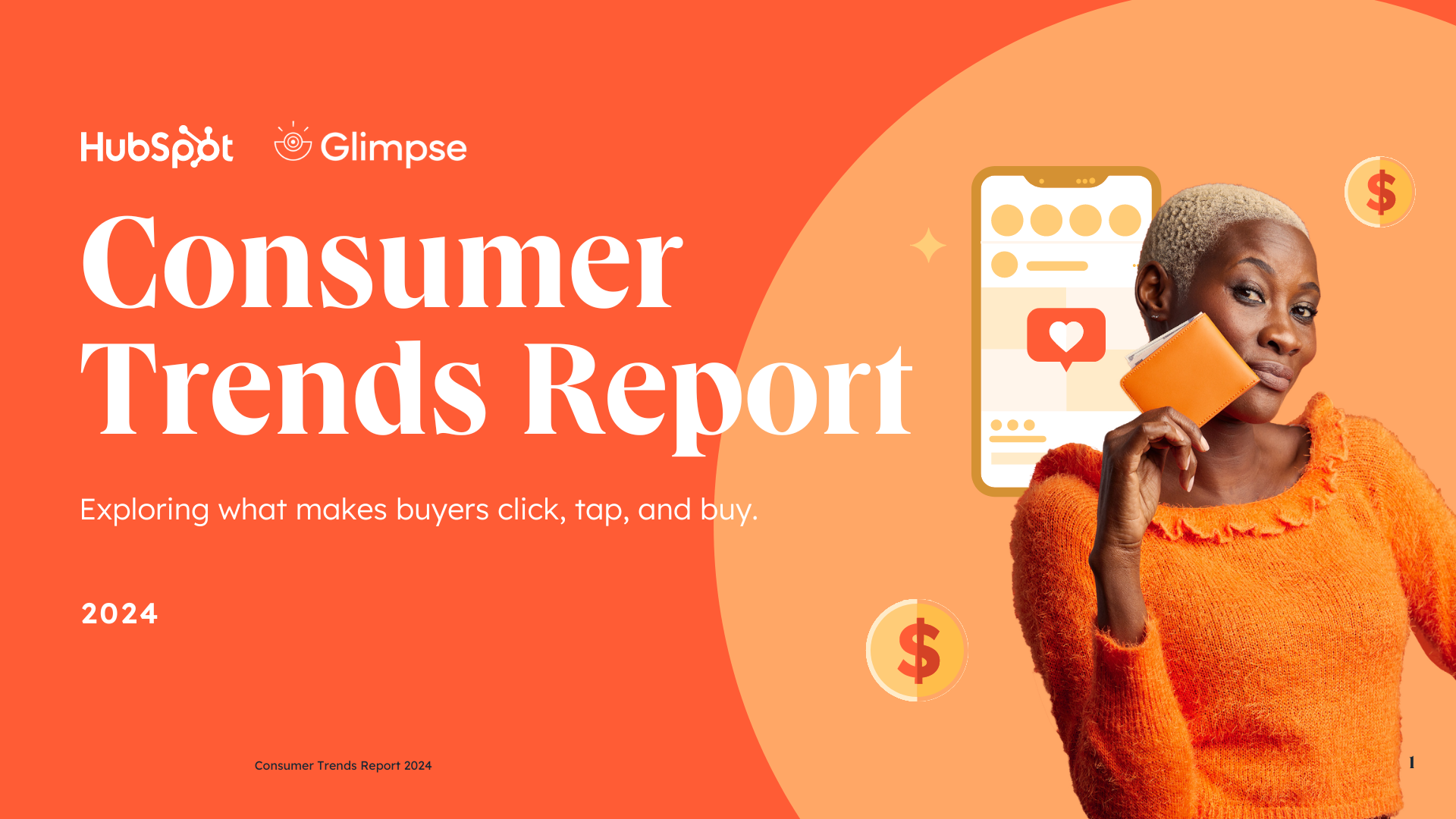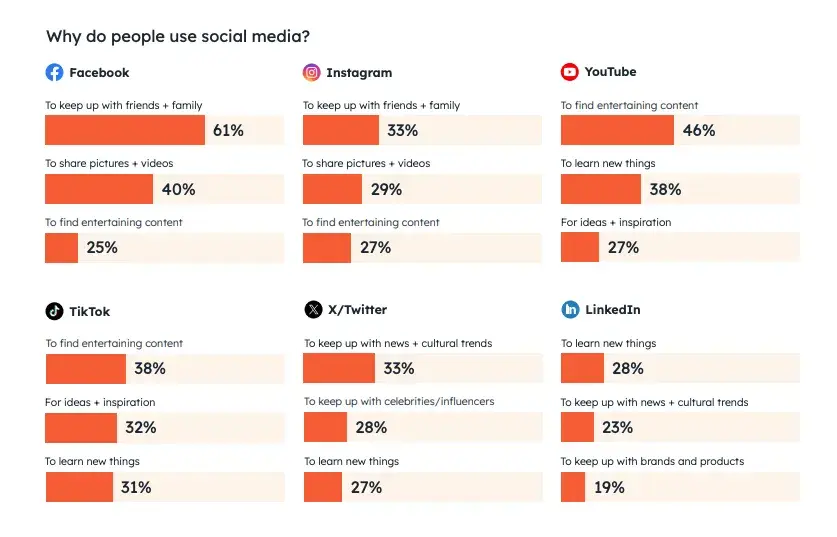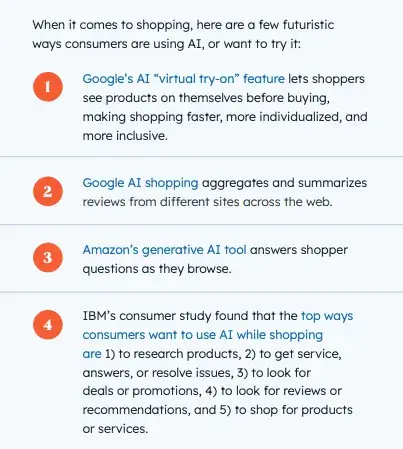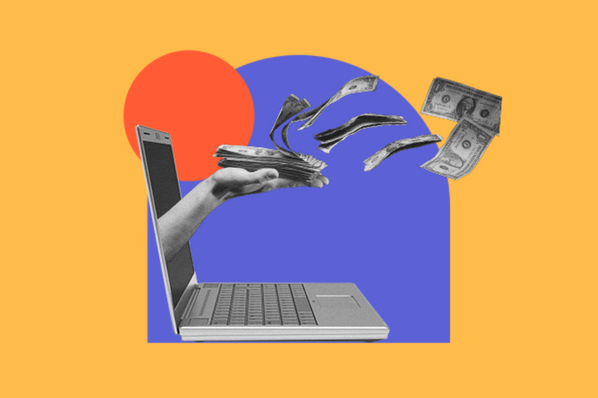From the rise of AI to shopping on social media, times are changing fast. Some consumer trends are a flash in the pan, but others represent a permanent change in buying habits. If your business doesn’t keep up with the latter, you could get left behind.
To help marketers and business owners stay ahead of the curve, we’ve surveyed 700+ U.S. adults for HubSpot’s annual Consumer Trends Report. Keep reading to keep a pulse on:
- How consumers spend their time online.
- How and where they prefer to shop.
- Which standards they’re holding their favorite brands to.
Download Now: The State of U.S. Consumer Trends
[Free Report]
Meet the Future Consumer
I spent a few hours digging through HubSpot’s survey results to uncover the top consumer trends in shopping, customer service, and technology. With voices and responses from over 700 people, here’s what I found.
The future consumer is digitally savvy, preferring mobile commerce and social media platforms for product discovery. Younger generations prefer influencer recommendations and short-form video content to get ideas and inspiration. Search patterns are changing, with customers starting to turn to social media and AI chat over traditional search engines.
Consumers want options from brands: More payment options and channel options for customer service. While more people are experimenting with AI, many don’t trust the tech yet.
Although convenience is important, it isn’t the only consideration for consumers. Sustainability, social advocacy, and data privacy are becoming more important for consumers making choices between brands.

U.S. Consumer Trends Report
Learn how consumers act, how they think, and what they expect now and beyond. Topics include:
- Purchase habits.
- Data privacy.
- Workplace trends.
- And more!
Download Free
All fields are required.

Digital Media Trends
Let’s dive into these trends one by one.
1. Social commerce is growing.
Social media platforms have become a top place for people to both discover and buy products.
Our Consumer Trends Report found that social media is the top channel for product discovery for Gen Z, Millennials, and Gen X.
This can be both passive, through scrolling through posts and videos, and active — like when someone searches for a particular product.

One in four social media users (and 43% of Gen Z) have bought a product directly through a social media app in the past three months.
Of the social media platforms, Instagram, Facebook, and TikTok are the most popular for direct purchases. Some consumers remain wary, however, about subpar customer service or getting scammed by fake shops.
2. Gen Z embraces new social media platforms, while legacy platforms stagnate.
87% of U.S. adults use social media. While legacy apps like Facebook and Instagram aren’t going anywhere, they also aren’t growing like they used to. Newer social media platforms like BeReal, Twitch, and TikTok are gaining traction, while established platforms like Facebook and Instagram see slower growth.
This shift is particularly pronounced among younger users. Facebook doesn’t crack the top three platforms Gen Z uses, while TikTok tops the list. Consumers are embracing decentralized platforms like Bluesky, Mastadon, or Discord as they retreat from X.
When choosing a platform to be on, keep in mind that consumers like different social media platforms for different reasons. People like Facebook and Instagram primarily to keep up with friends and family, while they pick up YouTube and TikTok to be entertained.

3. Search behavior is changing.
While traditional search engines remain dominant, social search and AI are disrupting the landscape.
Google enjoyed 90% of the search engine market share from 2015 to 2024, but in January 2025, the giant’s monopoly dipped below 90% for the first time in a decade. The reasons for this are three-fold:
- The rise of alternate search engines. Small numbers of users are migrating to privacy-centric search engines like DuckDuckGo and Bing.
- AI-enabled search. Rather than turning to Google, consumers are starting to search for products and ideas on apps like ChatGPT or Perplexity. Experts expect ChatGPT alone to take 1% of the search market in 2025. Our survey found that 72% of consumers plan on using gen AI-powered search for shopping in the future. Of those already using it, 79% said their experience was better than shopping experiences with traditional search.

- Social product discovery. As I’ve already covered, younger consumers are turning to social media platforms to find inspiration and products. 36% of social media users say they search for brands and products or services on platforms, and 24% search for local shops or businesses. 18% of consumers (and 31% of Millennials) say they turn to platforms like YouTube to search for answers to questions instead of Google.
4. Economic uncertainty means tighter budgets.
Most businesses aren’t sure what to make of the economy in 2025. Consumers aren’t either. While people we surveyed disagree about whether we’re in a recession, the impact is real: 47% say they’ve taken steps to prepare for a potential recession.
Here’s how that translates to spending: 55% of people say they’re tightening their budgets because of current economic conditions, while just 11% say they’re loosening them. This doesn’t mean consumers aren’t spending — they’re simply prioritizing intention and necessities over impulse purchases.
5. Data privacy reigns.
75% of consumers now believe that data privacy is a human right. While data protections are much stricter in Europe than in the U.S., consumers are making their preferences known.

We asked what would make consumers more comfortable sharing data with companies, and it comes down to trust, transparency, and security.
Of consumers, 75% want to be in control of what’s happening with the information they provide — what data is collected, how it’s used, and with whom it’s shared.

6. Consumers are divided on social advocacy from brands.
Consumers are divided about the role companies should play in social advocacy. There are large differences of opinion on whether companies should be vocal on social issues or stay out of it: 43% say brands should not take a stance, while 36% say they should.
Take a look at Target, for example. The retailer was one of the most outspoken advocates of DEI during the Black Lives Matter wave of 2020 and 2021. In early 2025, Target dropped its DEI initiatives, sparking praise from a few but a large outcry and a 40-day boycott from many longtime customers.
The top issues consumers want to hear about are affordable healthcare, climate change, and income inequality. 55% of consumers believe companies should advocate for racial justice, while just 15% say they shouldn’t.
Speaking out can be a gamble — but so can staying silent. The key is to know your audience well so you can follow their lead and act on the values that are important to your brand and leadership.

U.S. Consumer Trends Report
Learn how consumers act, how they think, and what they expect now and beyond. Topics include:
- Purchase habits.
- Data privacy.
- Workplace trends.
- And more!
Download Free
All fields are required.

7. Green is the new black.
Sustainability is a non-negotiable expectation for products and services across all industries. Consumers are increasingly prioritizing sustainability in their purchasing decisions.
In fact, 58% of consumers globally are willing to pay more for eco-friendly products, with Millennials (60%) and Gen Z (58%) leading this trend. Brands that emphasize transparency in sourcing and production are likely to gain a competitive edge in 2025.
8. AI as a personal assistant.
AI is becoming the ultimate personal assistant, offering personalized and predictive solutions in our personal and professional lives. When I need to find an appropriate product, check on an order status, or file an insurance claim, I can often do it 24/7 through an AI assistant.
This matches the trend of self-service that I’ve seen growing for some time. Our research found that when researching a brand or product, 59% of consumers prefer to gather information themselves rather than speak to a human. They also expect immediate problem resolution on the channel of their choice.
This doesn’t apply just to shopping, but to customer services and sales. If you haven’t already, consider setting up an AI assistant or chatbot to help consumers answer basic questions, request customer service help, or schedule appointments.

9. Make it omnichannel.
Customers want a seamless integration of digital and physical shopping experiences, across multiple channels. They expect ultra-convenient, frictionless experiences in every interaction with brands and services.
For example, if I chat with a business on Facebook Messenger about a return, I expect them to be able to pull up my order. On the business side, we call this omnichannel experience.
Here are the channels that customers prefer for interacting with brands:
- Phone (49%)
- In-person at a physical store (44%)
- Email (32%)
- Live chat tool/chatbot (25%)
- Text message/SMS (22%)
That’s a tall order for businesses to serve customers through all of those channels and keep the context and level of service the same across each one.
So, what does it take to create an omnichannel experience? You need an integrated platform that can sync customer data across channels and equip marketing teams, customer service reps, and AI assistants with the context and agency they need to serve customers’ needs.

10. Mobile commerce dominates.
Big purchases call for big screens? Not anymore. It comes as no surprise to me that mobile commerce now dominates online shopping.
Consumers HubSpot surveyed said they use mobile phones more than any other device for online shopping and when searching for questions online. That’s particularly true for Gen Z, of which 81% use their phone as their primary shopping device.
11. Memories over materials.
Have you asked for an experience gift like a concert or class for Christmas? Or contributed money to someone’s honeymoon fund instead of a wedding gift?
Americans are increasingly valuing experiences over material goods, with 58% preferring to spend money on experiences — 14% higher than the global average.
This trend is driving growth in sectors like travel, entertainment, and experiential retail as people seek meaningful, shareable moments rather than accumulating more stuff.
12. Influencers are here to stay.
In 2025, 29% of people say they’ve discovered a product through an influencer on social media.
Gen Z social media users say that influencer recommendations are more impactful than family and friend recommendations, though their elder generations disagree.
The number of people who consider themselves influencers is surprisingly large: 21% of people — and a whopping 45% of Gen Z and Millennials — consider themselves influencers or content creators.
24% of brands work with influencers for campaigns, and most say that it’s an effective marketing strategy. Brands have found particular success with micro-influencers with a niche audience and 10,000 to 99,999 followers.
13. AI adoption is growing, but trust remains low.
AI adoption is becoming widespread, but consumers are still skeptical. We found that one in three consumers uses AI tools like chatbots and ChatGPT, but trust is still low. 17% of customers “strongly distrust” and 16% “somewhat distrust” AI tools, while 35% neither trust nor distrust them.
That means that as you roll out AI tools, you’ll need to work hard to build trust and communicate with transparency.
14. Pay how you want.
With the explosion in payment methods from Venmo to CashApp to Zelle to even cryptocurrency, consumers want the convenience of alternate payment methods.
There’s also a trend that customers don’t want to pay just once upfront. Our survey found that just 63% want to pay for a product at full price. Alternately, 21% want to pay in installments (Buy Now Pay Later or BNPL), and 17% prefer a subscription model. Research shows that 8% of consumers already use BNPL, and 31% pay for a digital streaming subscription.
To stay competitive, consider expanding the payment options you accept.
15. Consumers crave authentic content.
Surprise! People actually want to see your content. But — and here’s the catch — they want it to be authentic and relatable. Almost two-thirds of consumers say it’s more important for marketing content to be authentic than polished.
While it’s good news that you don‘t need a huge budget to woo your audiences, you will need to create content they’ll actually enjoy, keep their attention on, and be persuaded by.
Videos and images are a great way to connect authentically with your customers and showcase the people behind your brand. Here are the types of content that customers say they enjoy the most:
- Images/photos/infographics (52%)
- Short-form video content like TikToks and Reels (45%)
- Live videos/live streams (35%)
- Long-form video content (24%)
Dive Deeper Into Consumer Trends
In the post above, I gave just a few highlights of our State of Consumer Trends Survey, as well as predictions for what's to come. Want to explore the latest Consumer Trends report and see how trends have changed over time? Click below to download the full findings of that survey in our State of Consumer Trends Report.
Editor's note: This post was originally published in May 2022 and has been updated for comprehensiveness.

U.S. Consumer Trends Report
Learn how consumers act, how they think, and what they expect now and beyond. Topics include:
- Purchase habits.
- Data privacy.
- Workplace trends.
- And more!
Download Free
All fields are required.



![4 shopping trends to expect in uncertain financial times [data + how marketers can adapt]](https://53.fs1.hubspotusercontent-na1.net/hubfs/53/consumer-recession-spend.webp)
![The Top Marketing Trends of 2025 & How They've Changed Since 2024 [Data from 1400+ Global Marketers]](https://53.fs1.hubspotusercontent-na1.net/hubfs/53/Untitled%20design%20(68).jpg)

.png)
![4 Marketing Trends & Strategies That Might Not Survive in 2025 [New Research]](https://53.fs1.hubspotusercontent-na1.net/hubfs/53/marketing%20trends%20that%20might%20not%20survive%202024.png)
![The HubSpot Blog's Marketing Leadership Report: How 720+ Brand Leaders Will Get Ahead in 2025 [+ How to Join Them]](https://53.fs1.hubspotusercontent-na1.net/hubfs/53/Copy%20of%20The%20Future%20of%20Work%20is%20Flexible%20%5BImage%2c%20IG%5D%20(598%20%C3%97%20398%20px)%20(595%20%C3%97%20400%20px)%20(517%20%C3%97%20517%20px).png)
![Top Shopping Trends of 2024 & How They've Changed [New Data]](https://53.fs1.hubspotusercontent-na1.net/hubfs/53/shopping-trends_3.webp)


![How Each Generation Shops in 2024 [New Data from Our State of Consumer Trends Report]](https://53.fs1.hubspotusercontent-na1.net/hubfs/53/how-each-generation-shops-1-20240801-5345961-1.webp)